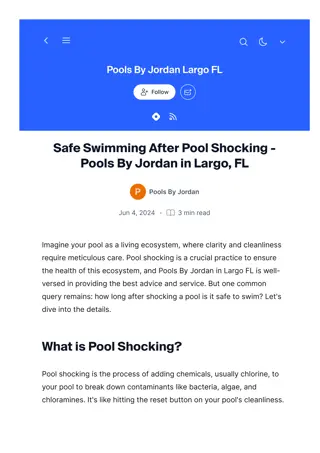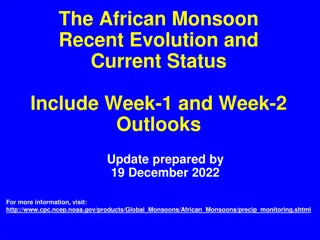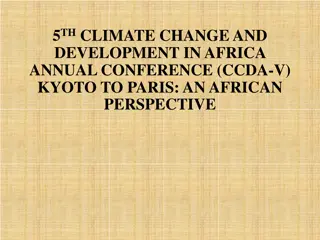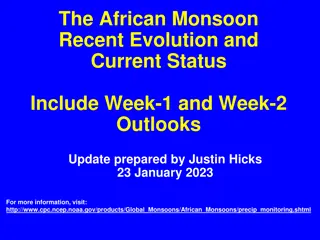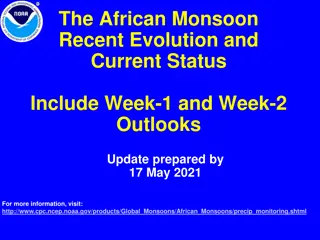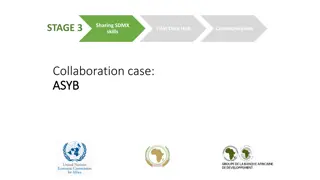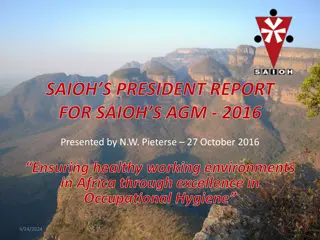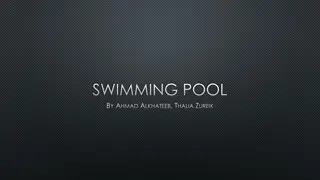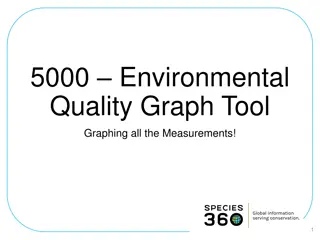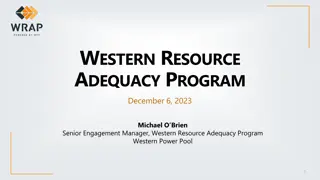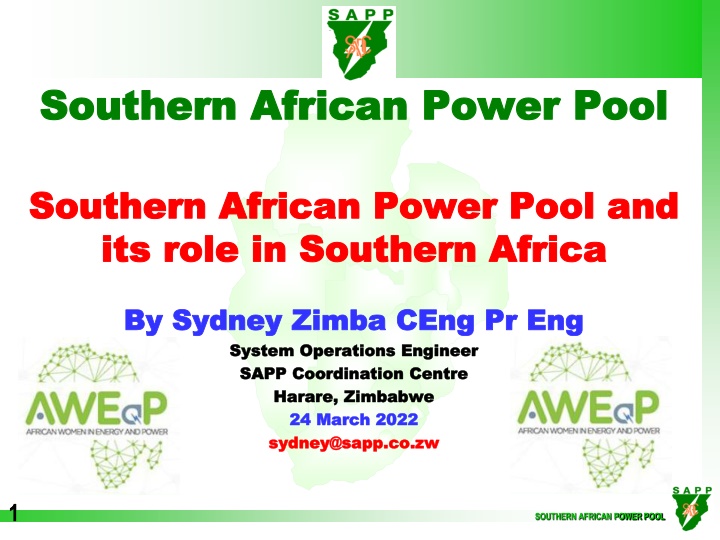
Southern African Power Pool and Its Role in Southern Africa
The Southern African Power Pool (SAPP) plays a crucial role in optimizing energy resources, enhancing power supply reliability, reducing environmental impact, and promoting regional integration in Southern Africa. Established in 1995, SAPP faces challenges of technical complexity and governance in managing interconnected power systems among member countries.
Download Presentation

Please find below an Image/Link to download the presentation.
The content on the website is provided AS IS for your information and personal use only. It may not be sold, licensed, or shared on other websites without obtaining consent from the author. If you encounter any issues during the download, it is possible that the publisher has removed the file from their server.
You are allowed to download the files provided on this website for personal or commercial use, subject to the condition that they are used lawfully. All files are the property of their respective owners.
The content on the website is provided AS IS for your information and personal use only. It may not be sold, licensed, or shared on other websites without obtaining consent from the author.
E N D
Presentation Transcript
Southern African Power Pool Southern African Power Pool Southern African Power Pool and Southern African Power Pool and its role in Southern Africa its role in Southern Africa By Sydney Zimba CEng Pr Eng By Sydney Zimba CEng Pr Eng System Operations Engineer System Operations Engineer SAPP Coordination Centre SAPP Coordination Centre Harare, Zimbabwe Harare, Zimbabwe 24 March 2022 24 March 2022 sydney@sapp.co.zw sydney@sapp.co.zw 1 1 SOUTHERN AFRICAN POWER POOL SOUTHERN AFRICAN POWER POOL
ABOUT INTERCONNECTED POWER ABOUT INTERCONNECTED POWER SYSTEMS SYSTEMS a) a) Advantages of Interconnection Advantages of Interconnection i. i. Optimization of energy resources and Optimization of energy resources and cost reduction reduction ii. ii. Power supply Power supply reliability reliability and security: Emergency support Emergency support Diversity (capability to meet peak load) Diversity (capability to meet peak load) Inertia and improved frequency control Inertia and improved frequency control iii. iii. Reduction of impact on the Reduction of impact on the environment iv. iv. Enhanced Enhanced regional integration regional integration and cooperation cooperation v. v. Alternative Alternative revenue streams revenue streams e.g. from power wheeling power wheeling cost and security: environment and e.g. from 2 2 SOUTHERN AFRICAN POWER POOL SOUTHERN AFRICAN POWER POOL
CHALLENGES OF INTERCONNECTED CHALLENGES OF INTERCONNECTED POWER SYSTEMS POWER SYSTEMS a) a) Technical Technical complexity i. i. System disturbances System disturbances ii. ii. Inter Inter- -area oscillations area oscillations iii. iii. Integrating ( Integrating (- - most power systems most power systems were not originally designed for were not originally designed for interconnection) interconnection) iv. iv. Inadvertent energy Inadvertent energy b) b) Governance Governance and and coordination c) c) Participation Participation costs costs complexity coordination 3 3 SOUTHERN AFRICAN POWER POOL SOUTHERN AFRICAN POWER POOL
SAPP Interconnected Power System SAPP Interconnected Power System SNEL DRC TANESCO TANZANIA PD = 1241 MW RNT ANGOLA PD = 2209MW PD = 1610 MW ZESCO/CEC/LHPC/Ndola Energy ZAMBIA PD = 2510 MW ESCOM MALAWI PD = 351 MW ZESA HCB/EDM/MOTRACO MOZAMBIQUE PD = 1948 MW NAMPOWER NAMIBIA PD = 695 MW ZIMBABWE PD = 1724 MW BPC BOTSWANA PD = 587 MW 533 kVDC 275 kV EEC ESWATINI PD = 226 MW 400 kV 220 kV ESKOM 330 kV 132 kV SOUTH AFRICA PD = 35005 MW 110 kV PD: Peak Demand Planned LEC 4 4 LESOTHO PD = 150 MW SOUTHERN AFRICAN POWER POOL SOUTHERN AFRICAN POWER POOL
SOUTHERN AFRICAN POWER SOUTHERN AFRICAN POWER POOL (SAPP) POOL (SAPP) a) Establishment: In 1995 at a SADC summit; member govts., except Mauritius, signed IGMOU b) Objectives: i. Cooperate and coordinate planning and operation of elec. power system; ii. Facilitate electricity trading; iii.Promote regional cooperation in power projects ( gen. & trans.); and, iv. Increase access to electricity. 5 5 SOUTHERN AFRICAN POWER POOL SOUTHERN AFRICAN POWER POOL
SAPP governing documents SAPP governing documents IGMOU: Established SAPP, revised 2006 i. ii. IUMOU: Management of SAPP, rev. 2007 iii. ABOM: For technical schedules and commercial transactions, rev. 2008 iv. Operating Guidelines: Operational codes, revised 2014 v. Market Guidelines: For market operations rules, signed 2014 vi. SAPP-CC Constitution: SAPP CC Management 6 6 SOUTHERN AFRICAN POWER POOL SOUTHERN AFRICAN POWER POOL
SAPP geographic view and key statistics (2021) i. 12 Countries, 3 not yet interconnected ii. 300 million people iii. Available generation capacity: 58,493 MW iv. Aggregate peak demand: 50,787 MW v. Annual energy consumption: 400 TWh vi. Deficit capacity: 1904 MW 7 7 SOUTHERN AFRICAN POWER POOL SOUTHERN AFRICAN POWER POOL
SAPP management and governance SAPP management and governance 8 8 SOUTHERN AFRICAN POWER POOL SOUTHERN AFRICAN POWER POOL
Current SAPP Membership Current SAPP Membership 1 2 3 4 5 6 7 8 9 10 11 12 No 13 14 15 16 17 18 Botswana Power Corporation Electricidade de Mocambique Electricity Supply Corporation of Malawi Rede Nacional de Transporte de ESKOM Lesotho Electricity Corporation NAMPOWER Societe Nationale d Electricite eSwatini Electricity Company Tanzania Electricity Supply Company Ltd ZESCO Limited Zimbabwe Electricity Supply Authority Full Name of Private Utility Copperbelt Energy Corporation Lunsemfwa Hydro Power Company Ndola Energy Corporation Hidro Cahora Bassa Mozambique Transmission Compamy GreenCo BPC EDM ESCOM RNT Eskom LEC Nam Power SNEL EEC TANESCO ZESCO ZESA Abbreviation CEC LHPC Ndola HCB MOTRACO GreenCo Botswana Mozambique Malawi Angola South Africa Lesotho Namibia DRC eSwatini Tanzania Zambia Zimbabwe Country Zambia Zambia Zambia Mozambique Mozambique Zambia OP OP NP NP OP OP OP OP OP NP OP OP Status ITC IPP IPP OB OB MP 9 9 SOUTHERN AFRICAN POWER POOL SOUTHERN AFRICAN POWER POOL MP: Market Participants
SAPP Installed Generation Capacity SAPP Installed Generation Capacity Wind 4.03% Landfill 0.03% Hydro 21.02% Solar PV 2.94% Solar CSP 0.97% Nuclear 3.01% OCGT 1.51% Distillate 4.38% Coal 62.05% Biomass 0.07% of 72156 MW of 72156 MW 10 10 SOUTHERN AFRICAN POWER POOL SOUTHERN AFRICAN POWER POOL
SAPP Project Advisory Unit (PAU) SAPP Project Advisory Unit (PAU) SAPP secured a grant funding from the World Bank and established a PAU to: i. Conduct analytical work for developing regional power projects; ii. Screen, select, prepare implementation of regional priority projects; iii. Coordinate technical, environmental, legal and financial studies of regional power projects; and, iv. Offer technical expertise to SAPP member utilities in project preparation and packaging. and monitor the 11 11 SOUTHERN AFRICAN POWER POOL SOUTHERN AFRICAN POWER POOL
Evolution of Electricity Markets in SAPP Evolution of Electricity Markets in SAPP FUTURE FUTURE ADDITIONS ADDITIONS PREVIOUSLY PREVIOUSLY Bilateral contracts Short-Term Energy Market (STEM) 2001 Post STEM (Balancing Market) 2002 Day-Ahead Market (DAM) 2009 Post Day Ahead Market (PDAM) 2013 Balancing Balancing Market Market - - 2022 Ancillary Ancillary Services Services Market Market Financial Financial Markets Markets 2001 2022 2002 2009 2013 EVOLUTION M A R K E T CURRENT CURRENT Bilateral contracts Day-Ahead Market (DAM) 2009 Forward Physical Market s (MA &WA) 2016 2016 Intra-Day Market 2016 2009 2016 12 12 SOUTHERN AFRICAN POWER POOL SOUTHERN AFRICAN POWER POOL
SAPP Competitive Electricity Markets SAPP Competitive Electricity Markets Total Traded Volumes (2019/20): 2,004.4 GWh FPM-W 7% FPM-M 2% IDM 11% DAM 80% 1,608 GWh 220 GWh 132GWh 45GWh A total of USD 146 SAPP competitive markets in the 2019/20 year. USD 146 million was exchanged on the 13 13 SOUTHERN AFRICAN POWER POOL SOUTHERN AFRICAN POWER POOL
SAPP Day Ahead Market (DAM) Prices SAPP Day Ahead Market (DAM) Prices SAPP prices are reflecting cost of supply in the region, informing critical bilateral and investment decisions. 14 14 SOUTHERN AFRICAN POWER POOL SOUTHERN AFRICAN POWER POOL
Other SAPP activities/roles Other SAPP activities/roles To effectively manage regional energy resources, SAPP is engaged in several other activities, including: i. Developing, adopting, and advising on standards and procedures for environmental protection; ii. Promoting energy efficiency; iii. Crime and theft prevention; iv. Collaborating with other power pools, regional and continental organisations, such as APUA, AFSEC, CIGRE, PIDA, for expertise sharing; v. Organising training and capacity building for member utilities. 15 15 SOUTHERN AFRICAN POWER POOL SOUTHERN AFRICAN POWER POOL
About Renewable Energy Sources About Renewable Energy Sources iii. Challenges: Quality of supply Impact on protection Impact on total inertia and stability Balancing load-generation Over-generation and increased transfers on tie lines Mitigation: Robust connection agreement Strong grid code; compliance Adequate monitoring and control resources (SCADA, human resources) Near accurate forecasts Examples: Wind, Solar, Biomass, Small hydro, Biogas i. Advantages: Environmentally friendly (low or zero carbon emissions); Zero marginal cost; Preferred by most funders. iv. ii. Characteristics: Intermittent output; Unpredictable (Generators cannot be dispatched); Location is constrained by availability of the primary resource; Nonsynchronous connection. v. 16 16 SOUTHERN AFRICAN POWER POOL SOUTHERN AFRICAN POWER POOL
Electricity Supply Electricity Supply Africa Perspective Africa Perspective i. African situation: Highest growth in electricity demand will be in Africa By 2030, 530 million people will lack access to electricity in Africa ii. Mitigation: Build a more reliable power system Target investment and maintenance to reduce power outages and decrease system losses Support African power pools and strengthen regional electricity markets Implement policy and regulatory measures to improve the financial and operational efficiency of utilities Tariff framework Facilitate a more effective use of public funds to attract private capital into power sector 17 17 SOUTHERN AFRICAN POWER POOL SOUTHERN AFRICAN POWER POOL
The End. The End. Thank you for your Thank you for your attention. attention. 18 18 SOUTHERN AFRICAN POWER POOL SOUTHERN AFRICAN POWER POOL




